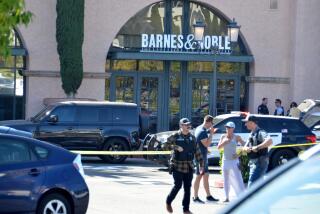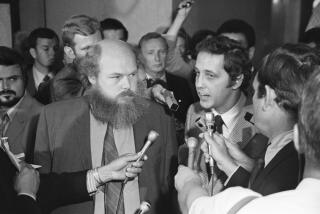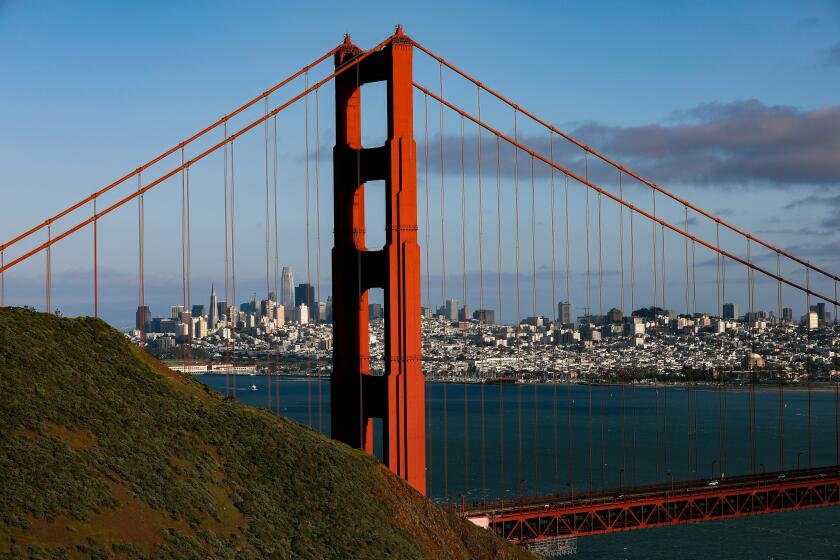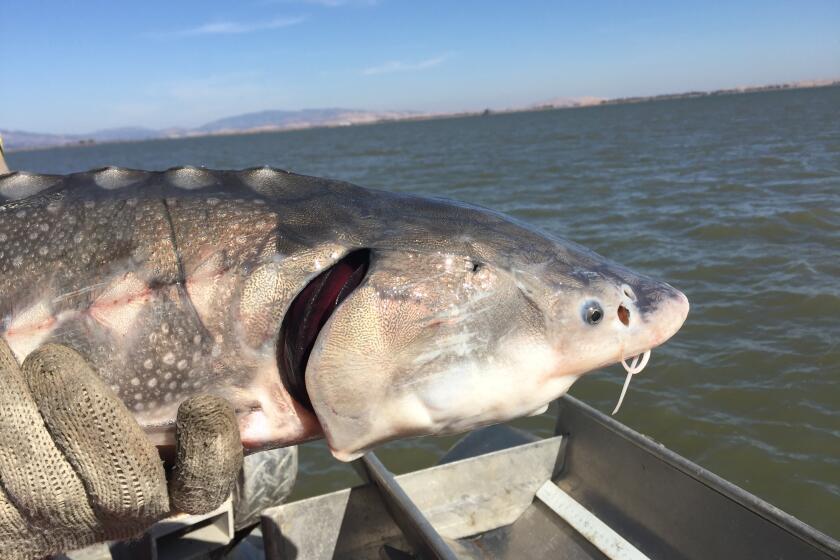In the Verdugos, a Rift Over a Development
The Verdugos, a 10-mile stretch of mountains on the northern edge of the Los Angeles Basin where coyotes, rabbits and lizards thrive in thick chaparral, has largely been spared the development that’s grown up around it.
Residents clustered around La Tuna Canyon Road like it just fine that way.
For the record:
12:00 a.m. Sept. 10, 2005 For The Record
Los Angeles Times Saturday September 10, 2005 Home Edition Main News Part A Page 2 National Desk 1 inches; 34 words Type of Material: Correction
Verdugo Mountains -- An article in the Aug. 30 California section about development in the Verdugo Mountains misidentified Verdugo Crestline Drive as Crestline Drive. Also, property owner Dale Echnoz was identified as Dale Stone.
Developer Rick Percell thinks there’s room for more, though, and his plan to develop one of the last large swaths of private land in the otherwise wild area has residents upset.
“You hate to see the whole world look like Valencia,” said Malcolm Cleaver, a retired city worker who lives along a winding dirt road off La Tuna Canyon Road, surrounded by cactus and panoramic views. His only regular companions are a bluetick hound named Cody and a mutt called Bo.
“It’s like, when is it going to stop?” he said, toweling water spots off his pickup truck as Cody lolled in the shade. “I’ve lived in L.A. all my life, and you get to know how L.A. works. So after a while you get a little bit cynical.”
At stake is a housing development that has been years in the making, one that environmentalists fear will start the slow march of homes up the mountainsides.
Percell -- no stranger himself to this land -- thinks he’s gone the extra distance to promote and defend his development. He has attended dozens of meetings of area residents over the years to allay fears about the project.
From a plan that once envisioned five-acre ranchettes spread over 887 acres, he’s condensed his development to 142 acres in a single canyon. By his calculation, he would use only 16% of the land he’s entitled to build on. The rest, he said, would remain open space.
Percell also has promised not to build south of the 210 Freeway. The area on that side of the freeway is considered a critical wildlife corridor for the San Gabriel Mountains.
But opponents say the only place the project will end up is in court, just as Orange County’s Bolsa Chica wetlands were for many years. They say fewer than 60 homes should be allowed because of the steep terrain.
Last month, they dressed in black and marched with a hearse containing an empty coffin to underscore their view that this plan could be the death of a cherished open space.
The Verdugos have a long history of being a target for development; at least one sprawling project that would have crept well up the hillsides was halted recently.
In 2003, Glendale won a 10-year battle to stop 572 luxury homes on 244 acres of land deep in the Verdugos. After a decade of lawsuits and community opposition, the developers agreed to sell the land to the Santa Monica Mountains Conservancy and Glendale.
That year, Los Angeles City Councilwoman Wendy Greuel pushed through an ordinance to protect prominent ridgelines in the Verdugos. The law stopped grading and development on the dramatic slopes that rise above Shadow Hills, Lake View Terrace and Tujunga.
The plan bars development within 60 vertical feet of ridgelines visible from six scenic corridors.
Though activism has concentrated on saving the ridgelines, this battle at the more quiet and rural northwestern end of the chain has drawn little attention.
It’s an area of narrow, winding roads where luxury homes abut seedier, neglected properties, some of which have abandoned stoves sitting behind garages. Homes on the south side of the freeway often have horses and barns, giving them a rural feel just minutes from Burbank. Sheep graze on one outlying plot.
Signs dotting the yards of homes around the project site read, “Save the Verdugos. Say No to Canyon Hills.”
One of the last houses on Cleaver’s road, Crestline Drive, is owned by activist Michele Stone and her husband, Dale. It was once a hunting cabin -- like many others in the area -- and the couple have remodeled it over the last 10 years.
Michele Stone said the best scenario would be construction so that no houses were visible from the 210 Freeway or La Tuna Canyon Road, but she doubted that would happen -- not with 230 homes going up.
Dale Stone worries that the solitude they cherish will be lost.
“I think it’s going to be a lot more crowded up here. I’m afraid this road is going to be opened up,” he said.
“Now, on Saturday, you can lie down in the middle of the road for an hour and no one would come by.”
Greuel said that given the choice, she would ban all development in the Verdugos. But she also said she is enough of a pragmatist to let the drama play out between the two factions. That means hashing it out through the zoning process and, if necessary, the courts. She knows Percell has the right to build. The question to be answered is how much.
“My goal has been to save as much open space as possible in perpetuity,” she said. To that end, she said, she has brought together Los Angeles Planning Commission members and opponents of the project in hopes of finding some common ground. And she contends that because of her work, building on the south side of the freeway probably will not happen.
Greuel said it’s all a question of short-term versus long-term thinking. She argues that a protracted fight over the land could risk the open space that Percell has agreed not to build on. And she also said there is little to prevent future rezoning of the land to allow more housing.
The matter may be considered by the Planning and Land Use Committee of the L.A. City Council next month. Opponents of the project predict that the committee will approve the project in some fashion, and they vow to take court action.
“This project has taken 10 years,” Percell said as he drove his Hummer along a dirt road that he hopes will be an emergency exit for his development. “I’ve been told I did not listen to people, and that is not true. I have listened to everything that is reasonable. I have been responsive.”
Percell said his plan addresses all legitimate objections, including the elimination of homes on the south side of the freeway. That cuts out roughly 50 houses from the original plan for 280. And he said the project is designed in such a way that it would be visible to 210 Freeway motorists for just a few seconds.
Much of the land involved in the project was purchased about 50 years ago by Lee Mansdorf, an aircraft salesman and entrepreneur who was one of the developers of the Pregnant Guppy, an oversized cargo plane that was used to transport Saturn V rocket boosters from California to Florida as part of the U.S. space program.
Percell said his father, Lloyd, became involved with the property about 20 years ago and called on his son to examine the rugged terrain and suggest a development scheme.
“My father came to me and said, ‘You’re a real estate developer. Take a look at it,’ ” Percell said. “But the property sat for many years.”
Lawyer William Eich, who has done a great deal of environmental work in that area of Los Angeles, said a tougher stand should be taken to ensure that the most land is preserved. His two main problems with the plan are the steepness of the terrain and the fact that the Planning Commission allowed the use of one topographic map over another, thereby allowing an increased number of homes on the site.
“I view this as the evisceration of the slope density of Los Angeles, and it has citywide implications,” he said. “A lot of the stuff on this land is straight up and down.”
He is joined in his objection by engineer Don Keene, who has done his own study of the building site. Keene’s conclusion was that the Planning Commission was relying on the way the slope density ordinance has been interpreted for almost 20 years rather than what the law demands.
“If the city favors the developer, the Verdugo Hills will be a memory,” he wrote in a recent memo. “The developers are aware of the development limitations when they buy a parcel of land. Their gamble or arrangement is to override existing zoning with the help of the Planning Department.”
Dean Wallraff, conservation chairman for the Verdugo Hills group of the Sierra Club, said he is practical enough to know that there will be some construction on the land, but the question is how much.
In his tour of the Verdugos, Wallraff drove his wife’s Honda SUV to a point overlooking the mountains to emphasize the wildness of the place, even though crowded Foothill Boulevard is just over the summit. And then he drove along the same rutted dirt road as Percell, where rabbits darted into the chaparral. He said that as much of the land as possible should be saved.
“We want more off the table,” he said.
Percell remains confident that at the end of the day, his side will prevail, though in what form is unclear.
“This is a normal process,” he said. “It’s taken longer than I’d like and had some bumps.”
Greuel urged patience: “There is no rush to judgment here.”
More to Read
Start your day right
Sign up for Essential California for news, features and recommendations from the L.A. Times and beyond in your inbox six days a week.
You may occasionally receive promotional content from the Los Angeles Times.






